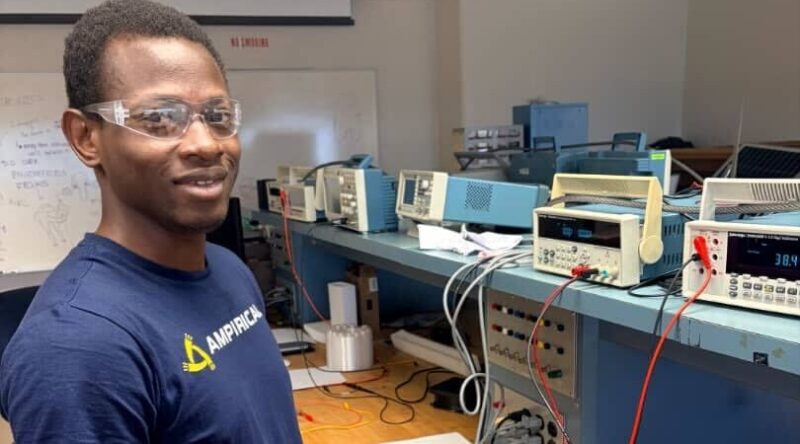By Olaoluwa John Adeleke
The lights flickered once. Then twice. By the third time, two million Texas homes had plunged into darkness. Hurricane Beryl’s aftermath in July 2024 wasn’t just another weather event; it was a stark reminder that our electrical grids remain vulnerable to failures that cascade faster than human operators can respond. Yet thousands of miles away, during that same scorching summer, California’s grid operators watched their own record-breaking heat wave with remarkable calm. Battery storage systems charged during abundant solar hours and discharged precisely when needed, keeping power flowing to millions of homes.
What made the difference? The answer lies not just in having more resources, but in knowing exactly what’s happening across the grid at every moment and using that knowledge intelligently.
The Hidden Complexity Behind Your Light Switch
Most of us flip light switches without considering the extraordinary ballet of coordination happening behind that simple action. Electricity travels at nearly the speed of light, demand fluctuates millisecond by millisecond, and the entire system must maintain perfect synchronization—in North America, exactly 60 cycles per second. Break that rhythm, and the consequences cascade rapidly.
Traditional power grids were engineered around predictability. Large coal and natural gas plants hummed steadily, their output easily controlled. Grid operators could forecast tomorrow’s demand based on yesterday’s patterns, adjusted for weather and season. This worked remarkably well for decades, achieving reliability rates exceeding 99.9% across much of the developed world.
But that world is changing faster than the infrastructure beneath it. Solar panels generate abundantly at noon but produce nothing at night. Wind turbines spin vigorously during storms but sit idle on calm days. In Spain and Portugal in April 2025, solar generation dropped from 18,000 megawatts to 8,000 megawatts within minutes as weather patterns shifted, a 10,000 megawatt swing equivalent to ten large power plants suddenly going offline. These aren’t failures; they’re the inherent characteristics of renewable energy that we must learn to anticipate and manage.
Add to this the emergence of energy consumers we couldn’t have imagined a decade ago. A single AI data center training large language models can consume as much electricity as a small city continuously, unpredictably, and with requirements that vary based on computational demands rather than weather or time of day. The North American Electric Reliability Corporation’s 2024 demand forecast grew by over 50% in a single year, an unprecedented jump driven largely by uncertainty about how many of these facilities will materialize and where.
When Prediction Becomes Prevention
This is where artificial intelligence enters not as hype, but as a necessity. The challenge isn’t just collecting data; modern grids already generate terabytes of measurements daily. The challenge is transforming that flood of numbers into actionable intelligence before small problems become catastrophic failures.
My research at the University of New Orleans Power and Energy Research Laboratory focuses on exactly this transformation. Working with IEEE test systems and real-world distribution networks, we’re developing predictive models that can identify the subtle warning signs of instability before they cascade into blackouts. Published research in IEEE SoutheastCon 2025 demonstrated an Energy Monitoring System capable of tracking voltage, current, power factor, and frequency in real-time, providing the continuous situational awareness that grid operators desperately need.
The system we developed, EMOSY, for the Energy Monitoring System, represents a practical approach to a universal challenge. Over sixteen days in May and June 2024, we collected data every minute from a distribution network experiencing significant operational stress. What we found was illuminating: voltage maintained remarkable stability around 222.5 volts despite surrounding grid instability, but only because our monitoring system could detect and respond to micro-variations invisible to traditional metering infrastructure.
Think of it like this: traditional meters are like checking your bank balance once a month. You know where you ended up, but you have no idea about the daily fluctuations that got you there. Advanced metering with AI analytics is like having a financial advisor who watches every transaction in real-time, spots concerning patterns, and alerts you before problems compound. For power grids, that difference between monthly snapshots and continuous monitoring can mean the difference between a managed adjustment and a cascading blackout affecting millions.
The Technology Behind Grid Intelligence
The technical architecture enabling this transformation consists of three interconnected layers, each addressing a specific challenge in modern grid management.
First: Enhanced Sensing and Data Collection
Traditional electrical meters simply recorded total consumption, useful for billing, but inadequate for managing a complex grid. Advanced Metering Infrastructure changes this fundamentally. Using IoT-enabled devices and high-frequency sensors, these systems capture not just how much energy flows, but its quality characteristics: voltage stability, current harmonics, power factor variations, and frequency deviations. Our research demonstrated system costs under $50 per monitoring point—60-80% less than conventional smart meters while providing superior data granularity.
This affordability matters enormously for developing economies and rural areas where infrastructure investment faces severe budget constraints. But the value proposition extends beyond cost. In our field deployment, we documented how real-time monitoring revealed patterns that monthly billing data would never capture: systematic voltage sags during peak hours, power factor deterioration indicating equipment stress, and consumption spikes correlating with specific weather conditions.
Second: Predictive Analytics and Pattern Recognition
Raw data becomes intelligence through sophisticated analysis. Machine learning algorithms excel at finding patterns in complex, high-dimensional data, exactly what power grids generate. Recent research published in Measurement: Energy demonstrates how AI-driven optimization can enhance battery performance in electric vehicles, techniques directly applicable to grid-scale energy storage management. The same pattern recognition capabilities that optimize battery charge-discharge cycles can optimize grid operations, predicting when and where demand will spike and pre-positioning resources accordingly.
Small-signal stability, the grid’s ability to maintain synchronization under minor disturbances, represents a particularly challenging prediction problem. Disturbances propagate through the network following complex physical laws, and renewable energy integration introduces new oscillation modes that traditional analysis methods struggle to characterize. AI models trained on years of operational data can recognize the precursor patterns to instability, providing operators with precious minutes of warning to take preventive action.
Third: Intelligent Response and Coordination
Prediction without action provides little value. The final layer involves automated systems that can respond faster than human operators while maintaining safety and coordination across the network. California’s battery storage success in 2024 wasn’t accidental—it resulted from intelligent dispatch algorithms that continuously optimized charge and discharge decisions based on real-time grid conditions and demand forecasts.
Digital twin technology, which I explored in research published in the International Journal of Industrial Engineering Research and Development, enables this coordination by creating virtual replicas of physical infrastructure. Operators can test response strategies in the digital twin before implementing them on the real grid, dramatically reducing the risk of unintended consequences. Smart substations equipped with these capabilities can detect faults, isolate problems, and reroute power automatically, all within milliseconds.
Global Lessons, Universal Principles
The challenges facing power grids aren’t confined to any single region or development level. Every grid operator worldwide grapples with the same fundamental questions: How do we integrate variable renewables while maintaining reliability? How do we plan infrastructure when demand forecasts vary by orders of magnitude? How do we respond to extreme weather events occurring outside historical patterns?
My work examining energy systems across different contexts, from research on smart cities published in IEEE Sensors Reviews to studies of renewable microgrid integration, reveals that solutions often emerge from unexpected places. Grid operators managing daily volatility develop adaptive strategies that prove valuable even in traditionally stable systems. The peer-to-peer energy trading models explored in my research for the International Journal of Research in Electrical and Electronics Engineering demonstrate how blockchain technology and distributed coordination can enable resilience through decentralization rather than centralized control.
Consider the parallels between challenges: whether managing renewable variability in Texas or Nigeria, coordinating battery storage in California or Kenya, the underlying engineering principles remain constant. Voltage must be maintained within acceptable ranges. Frequency must stay synchronized. Generation and consumption must balance continuously. The specific numbers differ, but the physics doesn’t change.
This universality suggests that innovations developed in resource-constrained environments often yield insights applicable to well-resourced systems. When you design monitoring systems assuming limited infrastructure, unreliable communications, and budget constraints, you tend to create resilient, efficient solutions. Those same characteristics, resilience and efficiency, increasingly matter in all power systems as complexity grows and margins tighten.
The Path Forward: Challenges and Opportunities
Despite rapid progress, significant challenges remain. Cybersecurity represents perhaps the most critical concern. As grids become more connected and automated, they also become more vulnerable to malicious attacks. A successful cyberattack on grid control systems could cause blackouts far more severe than any equipment failure. Research into secure communication protocols, encrypted data transmission, and resilient control architectures must keep pace with grid modernization efforts.
Data privacy presents another complex challenge. Advanced metering can reveal household activity patterns with remarkable precision when residents wake, leave for work, run major appliances, and sleep. This raises legitimate questions about surveillance and data ownership that technology alone cannot answer. Establishing appropriate governance frameworks requires balancing the operational value of detailed data against individual privacy rights.
Economic considerations also loom large. While costs for monitoring equipment and AI analysis have dropped dramatically, large-scale deployment still requires substantial investment. Utilities operate under regulatory frameworks that often don’t incentivize innovation, preferring proven approaches over novel solutions. Demonstrating clear return on investment through reduced outages, improved efficiency, and better integration of renewable resources remains essential for widespread adoption.
Yet the opportunities dwarf these challenges. NERC warns that over half of North America faces energy shortfall risks within five years, driven by explosive demand growth colliding with inadequate infrastructure expansion. We cannot build our way out of this gap using traditional approaches; the timeline simply doesn’t align. But we can optimize what we have, using intelligence to extract more capability from existing infrastructure while strategically deploying new resources where they matter most.
Battery storage deployment demonstrates this potential. The United States added 10.4 gigawatts of storage in 2024 and plans 19.6 gigawatts in 2025, nearly doubling annually. But storage value depends entirely on intelligent dispatch. Charge at the wrong time, and you waste renewable energy. Discharge at the wrong time, and you miss the peak demand when storage provides maximum value. AI-optimized dispatch algorithms can maximize this value, making storage investments work harder.
Similarly, demand response programs where consumers agree to reduce usage during peak periods in exchange for lower rates become far more effective with predictive intelligence. Rather than broad appeals for conservation, targeted requests can go to specific customers at precise times based on real-time grid conditions and localized constraints. Research shows this targeted approach can reduce peak demand by 15-20% compared to 5-10% for untargeted programs.

Implementation: From Laboratory to Reality
Translating research into operational systems requires bridging a significant gap between academic demonstrations and utility-grade reliability. Laboratory conditions allow controlled experiments with known variables. Real power grids operate continuously under unpredictable conditions with safety requirements that demand redundancy and fail-safe defaults.
Our approach emphasizes practical deployment from the outset. The EMOSY system uses commodity hardware NodeMCU microcontrollers and PZEM-004T energy monitors—specifically to demonstrate that sophisticated monitoring doesn’t require exotic components. The entire system communicates via standard Wi-Fi and stores data using readily available cloud platforms. This design philosophy prioritizes reproducibility and scalability over technical sophistication for its own sake.
Field validation revealed challenges that laboratory testing missed. Communication reliability suffers during extreme weather precisely when monitoring becomes most critical. Power supply fluctuations can damage sensitive electronics. Users need interfaces that present complex information clearly without requiring technical training. Each challenge led to design iterations, improving robustness with each deployment.
Collaboration with utility operators proved invaluable. They provided insights into operational constraints, regulatory requirements, and integration with existing systems that academic research rarely considers. For instance, any new monitoring system must coexist with legacy infrastructure that cannot be replaced overnight. It must provide outputs in formats compatible with utility control systems. It must fail safely, reverting to manual control rather than causing inadvertent blackouts.
The Human Element: Training and Adoption
Technology alone cannot transform grid operations. People must trust new systems, understand their capabilities and limitations, and develop new operational procedures that leverage enhanced intelligence effectively. This human element often determines success or failure more than technical performance.
Training programs must address multiple audiences. Grid operators need to understand what AI predictions mean, when to trust them, and how to intervene when automated systems make questionable decisions. Maintenance personnel must learn new troubleshooting procedures for digital systems, quite different from traditional electrical equipment. Executives and policymakers need sufficient technical literacy to make informed investment decisions without becoming engineers themselves.
Change management represents another critical challenge. Utilities have operated in certain ways for decades, building deep institutional knowledge around traditional approaches. New systems can feel threatening rather than enabling, particularly to experienced personnel who know how to manage grids using existing methods. Successful adoption requires demonstrating clear value while respecting existing expertise, positioning new capabilities as tools that enhance rather than replace human judgment.
Looking Ahead: The Grid of 2035
Projecting a decade forward, several trends seem likely to converge. Renewable energy will constitute the majority of new generation capacity globally, driven by declining costs and climate imperatives. Electric vehicle adoption will continue accelerating, adding both load and potential flexibility through vehicle-to-grid capabilities. AI data centers and other computational facilities will reshape demand patterns in ways we’re only beginning to understand.
The grids managing these changes successfully will share common characteristics. They’ll sense conditions continuously with high resolution. They’ll predict future states accurately across multiple time horizons, minutes for frequency stability, hours for economic dispatch, days for maintenance planning, and years for infrastructure investment. They’ll respond automatically to routine disturbances while alerting human operators to novel situations requiring judgment. They’ll operate as platforms enabling diverse participants, generators, storage operators, consumers, and aggregators to coordinate effectively through well-designed market mechanisms and technical standards.
Critically, these advanced grids will achieve higher reliability while accommodating more variability. This apparent contradiction resolves through intelligence. When you know exactly what’s happening and can predict what’s coming, you can prepare responses that keep the system stable despite underlying volatility. It’s the difference between white-knuckle driving in fog versus confidently navigating clearly visible roads.
Research continues to advance on multiple fronts. Quantum computing may eventually enable optimization calculations impossible with classical computers, though practical quantum advantages remain years away. Edge computing brings intelligence closer to sensors, reducing latency and communication bandwidth. Advanced materials promise better batteries, more efficient power electronics, and sensors that measure phenomena currently invisible. Each advance creates new possibilities while introducing new complexities to manage.
The Broader Context: Energy Access and Equity
Grid intelligence isn’t merely a technical challenge; it’s fundamentally about ensuring reliable, affordable electricity access for everyone. The 770 million people worldwide lacking electricity access entirely, and the billions more experiencing frequent outages, need solutions that work with limited infrastructure and constrained budgets. This is where affordable monitoring, distributed intelligence, and resilient design become not just nice-to-have features but essential requirements.
My research on energy access, including work on flexible energy storage devices published in the Global Journal of Engineering and Technology Advances, explores how advanced technologies can leapfrog traditional infrastructure limitations. Just as mobile phones enabled communications in regions that never built extensive landline networks, intelligent distributed energy systems can provide reliable power without requiring centralized generation and transmission infrastructure.
The equity dimensions extend beyond global considerations. Within developed economies, low-income communities often experience more frequent and longer outages than affluent areas, despite paying the same or higher rates. They have fewer resources to cope with outages, no backup generators, limited food storage capacity during refrigerator outages, and health impacts from losing air conditioning during heat waves. Improving grid reliability provides disproportionate benefits to those who currently suffer most from its failures.
Conclusion: Intelligence as Infrastructure
We stand at an inflection point in electric grid evolution. The transition to renewable energy, the electrification of transportation and heating, and the emergence of new loads like AI data centers create challenges unprecedented in power system history. Meeting these challenges requires more than incremental improvements in traditional approaches. It requires fundamentally reimagining how we sense, analyze, and control these vast interconnected systems.
Artificial intelligence and advanced monitoring provide the tools for this transformation, but technology implementation requires careful attention to reliability, security, economics, and human factors. The goal isn’t building the most sophisticated system possible but building the most effective system practical one that prevents blackouts, integrates renewables, serves customers reliably, and does so affordably.
My research journey from developing monitoring systems for challenging grid environments to exploring stability analysis and renewable integration reinforces one central insight: the solutions to our most pressing energy challenges will emerge from the intersection of electrical engineering, computer science, data analytics, and practical operational experience. We need engineers who code and data scientists who understand power systems. We need solutions proven in laboratories and validated in field deployments. We need innovation grounded in physical reality.
The next blackout doesn’t have to happen. With sufficient intelligence embedded in our grids, we can see problems forming, predict their trajectories, and take preventive action before lights flicker. That future is within reach, not through any single breakthrough, but through the patient, persistent work of developing, testing, and deploying the technologies that make it possible.
The challenge ahead is substantial. The opportunity is larger still. And the work continues.
About the Author:
Olaoluwa John Adeleke is a Graduate Research Assistant in the Power and Energy Research Laboratory (PERL) at the University of New Orleans, where he researches power system stability, blackout prediction, and renewable energy integration. His work has been published in IEEE SoutheastCon, IEEE Sensors Reviews, Measurement: Energy, and other peer-reviewed venues.
Connect with me on LinkedIn: linkedin.com/in/olaoluwaadeleke
See also: How Nigeria’s new digital economy bill could make government finally work like your banking app








